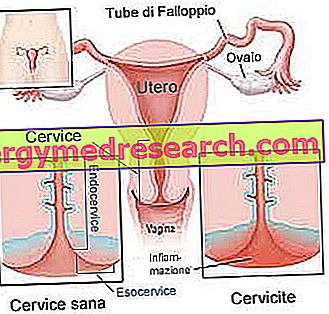Definition of cervicitis
The term "cervicitis" defines an inflammatory process, with an acute or chronic course, involving the uterine cervix (or cervix). Often, cervicitis is an expression of venereal diseases, but other causes of an extra-infective nature have also been identified.
Cervicitis can be completely asymptomatic; therefore, in the absence of symptoms, the patient is not aware of the ongoing inflammation.

Cervicitis is a disease generally of simple resolution, provided it is dealt with early; the goal of medical treatment is the removal of the root cause and the prevention of complications. The cervix serves as a natural protective barrier against viral, fungal and bacterial attacks: it is clear that, in the presence of infections at the level of the cervix, the risk of spreading pathogens in the uterus (metritis) and tubes (salpingitis) increases exaggeratedly.
Let us now analyze the distinctive features of cervicitis in more detail.
Causes and risk factors
It is first of all necessary to distinguish infective cervicitis from non-infectious forms.
Often, the cause of cervical inflammation lies in a sexually transmitted disease, particularly trichomoniasis, gonorrhea, chlamydia, syphilis (less frequently) and genital herpes.
The appearance of symptomatic cervicitis can also be favored by vaginitis, a disorder characterized by an abnormal and uncontrolled growth of commensal bacteria (eg staphylococci and streptococci) normally present in the vagina.
- Chlamydia (conveyed by Chlamydia trachomatis ) appears to be the etiopathological agent most involved in cervicitis. The cervical inflammation caused by chlamydia amounts to 40% of cases.
- Gonorrhea ( Neisseria gonorrhoeae ) Cervicitis due to gonorrhea occurs with purulent symptoms
- Genital herpes: less frequent
- Syphilis (carried by Treponema pallidum ): infrequent
- Trichomoniasis (from Trichomonas vaginalis ): less frequent
- Mycoplasma genitalium and M. tuberculosis : the role of these pathogens in the pathogenesis of cervicitis is not yet clarified
- There is no proven evidence that Papilloma Virus can cause cervicitis
Cervicitis that does not depend on venereal diseases appears to be favored by the placement of uterine devices, such as contraceptive diaphragms, or by allergic reactions to spermicides or latex condoms. Also the excessive exposure to irritating chemical substances or too frequent vaginal lavages can favor the onset of cervical inflammatory episodes. Systemic inflammatory disease (Behçet's disease) and cervical cancer are also among the possible factors triggering non-infectious cervicitis.
Among the predisposing risk factors, we recall:
- Past history of sexually transmitted diseases
- Occasional sexual relations, frequent and unprotected, with partners at risk
- Early sexual activity begins
Symptoms
CLASSIFICATION
Cervicitis can be classified into:
- Exocervicitis and endocervicitis: depending on the precise locus in which the infection develops (the exocervix or portio is the part of the cervix that protrudes into the vagina like the face of a tench, while the endocervix is the innermost part which includes the cervical canal and superiorly continues with the uterine isthmus)
- Acute and chronic: based on the intensity, type and duration of symptoms
ENDOCERVICITE: inflammation occurs at the level of the cervical canal. Door erosion is not always present
EXOCERVICITIS: inflammation affects the intravaginal portion of the cervix. There is always a glandular inflammation of the portoo.
The ACUTE form of cervicitis is rather rare and generally of short duration: in fact, the infection to the cervix tends to CHRONICIZE, also involving the endocervix. Bacterial cervicitis occurs with the characteristic symptoms of inflammation.
Signs and Symptoms
To learn more: Cervicitis symptoms
Cervicitis can be diagnosed randomly: it is not uncommon, in fact, that inflammation in the cervix is completely asymptomatic or paucisymptomatic. However, in the presence of suggestive symptoms, we must distinguish the signs and prodromes that differentiate infective cervicitis from those dependent on other factors.
The cervicitis related to venereal diseases are often marked by abnormal vaginal discharge of color ranging from yellow to greenish; possible also dysuria, post coital bleeding, spotting and vaginal secretions purulent mucus.
Characteristic of cervical extra-infectious inflammations are skin sores, circumscribed erythema and localized petechiae ("strawberry cervix").
Among the general symptoms, often associated with all variants of cervicitis, abdominal pain, the perception of discomfort during urination and dyspareunia (pain during sexual intercourse) are the most common.
Diagnosis
It is not uncommon for cervicitis to be detected randomly, just during a simple routine gynecological exam. From what has been said it is clear that it is essential to undergo regular checks, especially after an unprotected sexual relationship with risky partners. A simple pelvic exam can show abnormal vaginal discharge, redness of the cervix and inflammation of the vaginal walls.
From the gynecological examination another kind of infection could also emerge - for example caused by yeasts or fungi (eg Candida albicans ) - which more often create damage to the vaginal and non-cervical level.
Even in the case of presumed cervicitis, it is strongly advised to undergo the examination for the eventual confirmation of concomitant venereal diseases, such as chlamydia or gonorrhea. A more in-depth investigation may rarely be required by means of colposcopy and cervical biopsy.
Cervicitis: drugs and treatments
To learn more: Drugs for the treatment of Cervicitis
Once the triggering factor has been identified with certainty, cervicitis is a fairly simple medical condition to treat.
In the event of bacterial cervicitis, antibiotics (eg Azithromycin, doxycycline, metronidazole, etc.) are the first choice medicines, while herpes virus cervicitis is eradicated with antiviral drugs (eg acyclovir, valacyclovir, etc.) .
The sexual partner should also undergo treatment for the treatment of infectious cervicitis, since it is a sexually transmitted disease. The therapy, also prophylactic, is useful to minimize possible and possible relapses, as well as avoiding complications and the typical rebound effect.
For menopausal women affected or predisposed to cervicitis a hormonal therapy based on estrogen and / or progesterone is eventually provided.
A particularly difficult to neutralize chronic cervicitis can be treated with more invasive therapeutic strategies, such as cryosurgery, electrocautery or laser therapy.
Prevention
It is possible to minimize the risk of cervicitis by taking care to use the condom in relationships with little-known partners. In case of latex condom intolerance, consult your doctor. It is also recommended to avoid the use of aggressive and irritating intimate cleansers, which could damage the already sensitive skin. Even excessive use of vaginal lavages could irritate the area, predisposing the woman to cervicitis.



